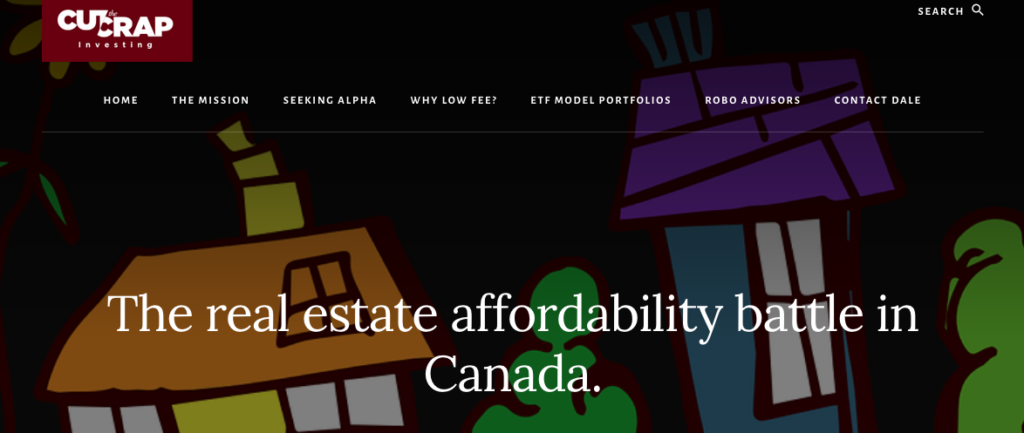By Dale Roberts, cutthecrapinvesting
Special to the Financial Independence Hub
In my latest for MoneySense, I look at the affordability battle in Canada. Home prices are falling at the fastest clip in the last 20 years. But borrowing costs are also increasing. Mostly, it’s a wash. Even from the bubble peak in February of 2022 to July 2022, things have not improved for homeowner wannabes. Real estate is the most interesting and ‘exciting’ sector in 2022. Have a read of the real estate affordability battle in Canada.
Higher rates take on falling home prices on MoneySense.

In this post I will offer up a few of the important charts, but check out that MoneySense post for the wider perspective.
Average home prices down 22% in July
Home prices are falling fast. After a strong COVID-inspired real estate run, prices are now in a free fall. After peaking at $816,720 in February 2022, the national average house price fell 18.5% to $665,850 in June. The average price fell again in July, settling at $629,971—nearly 22.9% below the peak.
The average national home price in August increased to $637,673.

The national average price is heavily influenced by sales in Greater Vancouver and the GTA, two of Canada’s most active and expensive housing markets. Excluding these two markets from the calculation cuts $114,800 from the national average price.
Real estate ridiculousness
And here’s some longer term history using average Toronto home prices as an example. It was a crazy run.
- Average Toronto home price in 2000: $243,255
- Average Toronto home price in 2010: $431,262
- Average Toronto home price in 2021: $1,095,336
Rates are going up, up, up
In that battle against runaway inflation, central bankers are raising rates. Borrowing costs mostly follow suit. Here’s the path in Canada for fixed and variable rates mortgages.

And of course, on Wednesday September 7, the Bank of Canada increased rates another 75 bps, or 0.75%. Variable is getting more expensive.
- A 5-year fixed will now run you about 5.04%.
- A 5-year variable will increase to about 4.90%.
The B0C offers that they’re not done yet. There are more rate hikes to come.
Given the outlook for inflation, the Governing Council still judges that the policy interest rate will need to rise further. Quantitative tightening is complementing increases in the policy rate. As the effects of tighter monetary policy work through the economy, we will be assessing how much higher interest rates need to go to return inflation to target. The Governing Council remains resolute in its commitment to price stability and will continue to take action as required to achieve the 2% inflation target.
Bank of Canada
Variable rates will automatically follow Bank of Canada rate hikes. Fixed rates will follow the bond market, and the bond market will make a guess about the near and future path of rate hikes. The rate hike on September 7 was mostly already priced into the bond markets.
The money chart on affordability
In the MoneySense post you’ll find the telling table comparing costs for variable and fixed rate mortgages, for 10% and 20% down payment scenarios. Here was the working copy table.
Thanks to Gina Athanasious, a RE/MAX real estate expert, for her help with the following calculations. Gina has been a wonderful sounding board during my real estate research and exploration.

And here’s the table breaking down the dollar cost (differences) for the scenarios.

Fixed rate mortages are slightly more ‘affordable’, variable rates are more expensive. And variable rate mortgages are even more expensive thanks to the recent additional rate hike. Early reports also show housing prices holding up quite well in August.
The affordability fix is nowhere to be seen
I asked Athanasious whether or not we could see improved affordability in the future. She says:
“Optimal affordability will arrive when the government focuses on a way to increase supply in a meaningful way. It all depends what your definition of affordability is at the end of the day. What is a reasonable and sensible amount to spend on housing compared to income? As you can see, affordability has not really improved. Rate hikes haven’t changed that. For me, the gap between salary and prices is too big to have anything considered affordable.”
While many real estate agents continue to sell the real estate dream, at all costs, I appreciate Gina’s honesty and candour. The overarching structural imbalance remains with new housing supply failing to meet the ongoing (and increasing) demand.
In the MoneySense post I offered that a favourable scenario of falling home prices and falling borrowing costs (in a recession) may present itself, but the shift will likely only be temporary, and it will be nearly impossible to time perfectly. Buyers will jump in early.
First time home buyers (waiting on the sidelines) should hope for a meaningful recession that does not cost them their job. They need a healthy down payment and should increase their savings rate. Keep the money safe in savings and short term GICs.
In that series of events, they might be able to take homes from millennials and from greedy boomer real estate (HELOC-high) “investors”.
Here’s a very good thread on underwater condo investors. Many are cashflow negative and it’s getting worse.
The factor driving all of the above is inflation, and the fight against inflation.
As with stock investing, home buyers won’t be able to time the markets. But I would suggest homeowner wannabes (consider) start the bidding process the moment affordability presents itself and they can qualify for a mortgage. And, of course, they should also ensure the mortgage is well within their financial comfort zone.
Thanks for reading. We’ll see you in the comment section.
 Dale Roberts is the owner operator of the Cut The Crap Investing blog, and a columnist for MoneySense. This blog originally appeared on Cut the Crap Investing on Sept. 8, 2022 and is republished on the Hub with permission.
Dale Roberts is the owner operator of the Cut The Crap Investing blog, and a columnist for MoneySense. This blog originally appeared on Cut the Crap Investing on Sept. 8, 2022 and is republished on the Hub with permission.



